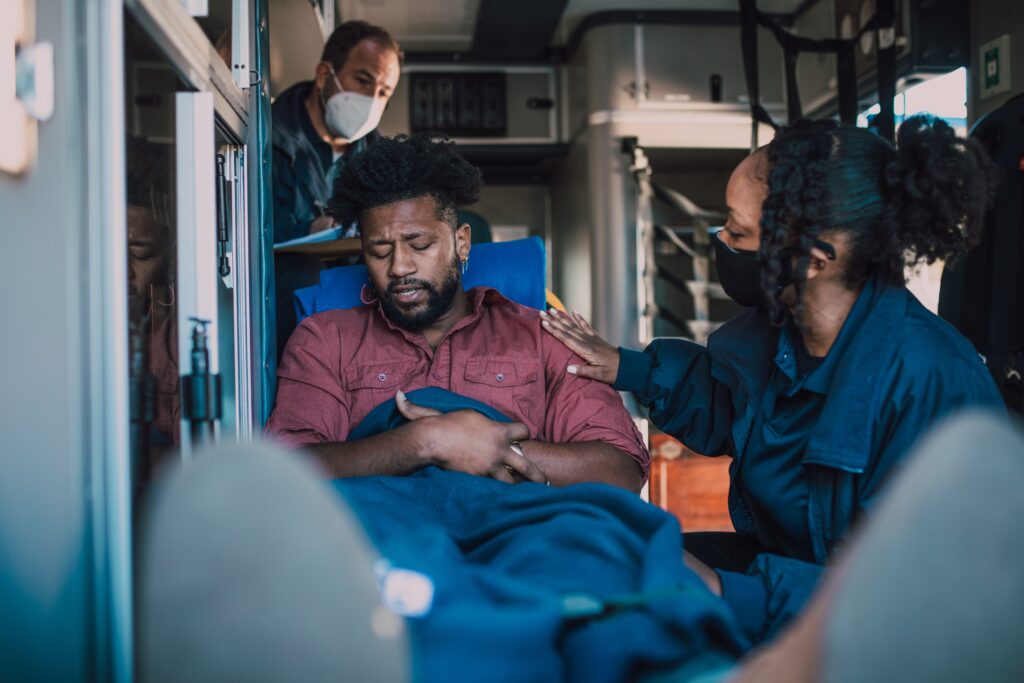August 13, 2023 – Attorney, Lauren N. Weber
What happens if an ambulance transporting a car crash victim is involved in an auto accident? Is the original defendant liable for the subsequent car accident? In the aftermath of a car accident, the injured party, known as the plaintiff, often pursues a negligence claim against the responsible party, referred to as the defendant. In the legal context of Florida, a negligence claim involves four critical elements: the recognition of a legal duty, a breach of that duty, proximate causation, and resulting damages. Clay Elec. Coop., Inc. v. Johnson, 873 So. 2d 1182, 1185 (Fla. 2003). However, an intriguing scenario arises when the plaintiff becomes involved in a subsequent collision when transported by EMS. In this complex situation, a fundamental question emerges. Is original defendant liable for the subsequent car accident, or does the subsequent crash sever their responsibility?

At the heart of this issue lies the element of proximate causation, which seeks to determine the extent to which the defendant’s actions foreseeably and significantly contributed to the specific injury that unfolded. Serrano v. Addison Grace Dickinson, 363 So. 3d 162 (Fla. Dist. Ct. App. 2023). The pivotal factor in determining liability when an intervening event occurs is the foreseeability of such an event. Delving further into proximate causation, it emerges as a critical component that evaluates the degree to which the defendant’s actions were responsible for the specific injury that materialized. McCain v. Fla. Power Corp., 593 So. 2d 500, 502 (Fla. 1992).
Generally, an individual who is negligent is responsible for any injuries that were foreseeable at the time of their negligent behavior. If the impact breaks the plaintiff’s arm. It’s a foreseeable injury and the proximate cause of the defendant’s negligent actions. But what happens if the ambulance gets into another crash while transporting the plaintiff. Or if the plaintiff bleeds out on the way to the hospital from an injury and dies. Both of these injuries are foreseeable and can be attributed to the defendant responsible for the first motor vehicle accident.
A defendant’s liability can be cut-off when the chain is broken. The concept of “breaking the chain of causation” is integral to understanding the dynamics of such cases. The trier of fact (the jury) plays a crucial role in evaluating whether the harm stemming from the subsequent incident falls within the scope of the risks attributable to the defendant’s initial negligent conduct. Nonetheless, instances can arise where the foreseeability of an intervening cause becomes a central point of contention.
While creating a hazardous situation might reasonably imply the need for assistance, it might not encompass foreseeing unconventional and reckless actions beyond ordinary expectations. Actions are not reasonably foreseeable can potentially alter the course of liability. Dep’t of Transp. v. Anglin, 502 So. 2d 896, 899-900 (Fla. 1987). This case demonstrated a compelling illustration of this legal scenario. The plaintiff suffered severe injuries when trapped between her stalled vehicle and another car that collided with it. The plaintiff’s vehicle became stuck due to accumulation of water at a railroad crossing when another driver recklessly collided with her vehicle.
The driver initially observed the plaintiff’s predicament and went to seek help, but subsequently chose to turn around and return to the scene. As he approached the scene, he was driving at unsafe speeds, lost control of his vehicle and pinned the plaintiff between her car and his. These actions constituted an independent, efficient, intervening cause of the plaintiff’s injuries. The court found it was not reasonably foreseeable that another party would act in such a bizarre and reckless manner. Since it was not reasonably foreseeable, the railroad could not be held liable for this collision.
As the interplay between negligence claims, proximate causation, and subsequent collisions unfolds, the legal landscape becomes more intricate. It is imperative for legal practitioners and individuals alike to understand the nuanced factors that influence the determination of liability in such complex scenarios.
If you or loved one were involved in a car accident, contact Weber Law Firm for a free consultation.
